Abstract
Angiotensin I-converting enzyme (ACE, kininase II) is a single-chain protein containing two active site domains (named N- and C-domains according to position in the chain). ACE is bound to plasma membranes by its C-terminal hydrophobic transmembrane anchor. Ileal fluid, rich in ACE activity, obtained from patients after surgical colectomy was used as the source. Column chromatography, including modified affinity chromatography on lisinopril-Sepharose, yielded homogeneous ACE after only a 45-fold purification. N-terminal sequencing of ileal ACE and partial sequencing of CNBr fragments revealed the presence of an intact N terminus but only a single N-domain active site, ending between residues 443 and 559. Thus, ileal-fluid ACE is a unique enzyme differing from the widely distributed two-domain somatic enzyme or the single C-domain testicular (germinal) ACE. The molecular mass of ileal ACE is 108 kDa and when deglycosylated, the molecular mass is 68 kDa, indicating extensive glycosylation (37% by weight). In agreement with the results reported with recombinant variants of ACE, the ileal enzyme is less Cl(-)-dependent than somatic ACE; release of the C-terminal dipeptide from a peptide substrate was optimal in only 10 mM Cl-. In addition to hydrolyzing at the C-terminal end of peptides, ileal ACE efficiently cleaved the protected N-terminal tripeptide from the luteinizing hormone-releasing hormone and its congener 6-31 times faster, depending on the Cl- concentration, than the C-domain in recombinant testicular ACE. Thus we have isolated an active human ACE consisting of a single N-domain. We suggest that there is a bridge section of about 100 amino acids between the active N- and C-domains of somatic ACE where it may be proteolytically cleaved to liberate the active N-domain. These findings have potential relevance and importance in the therapeutic application of ACE inhibitors.
Full text
PDF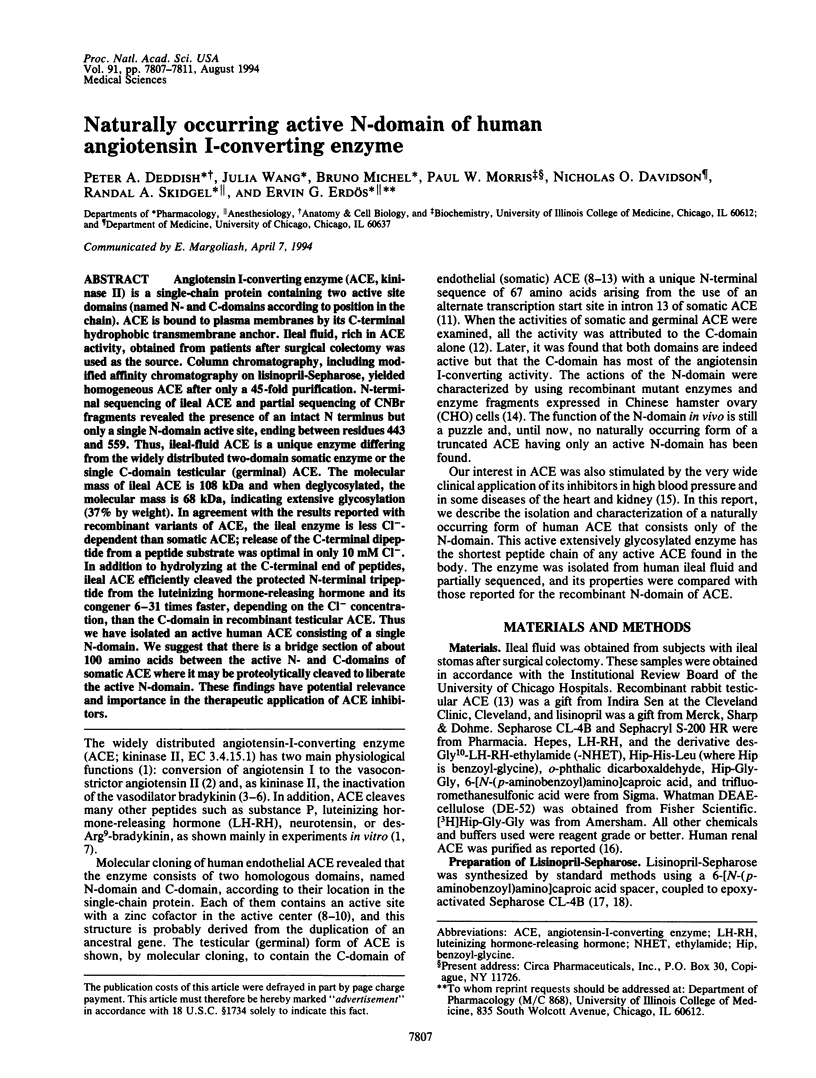
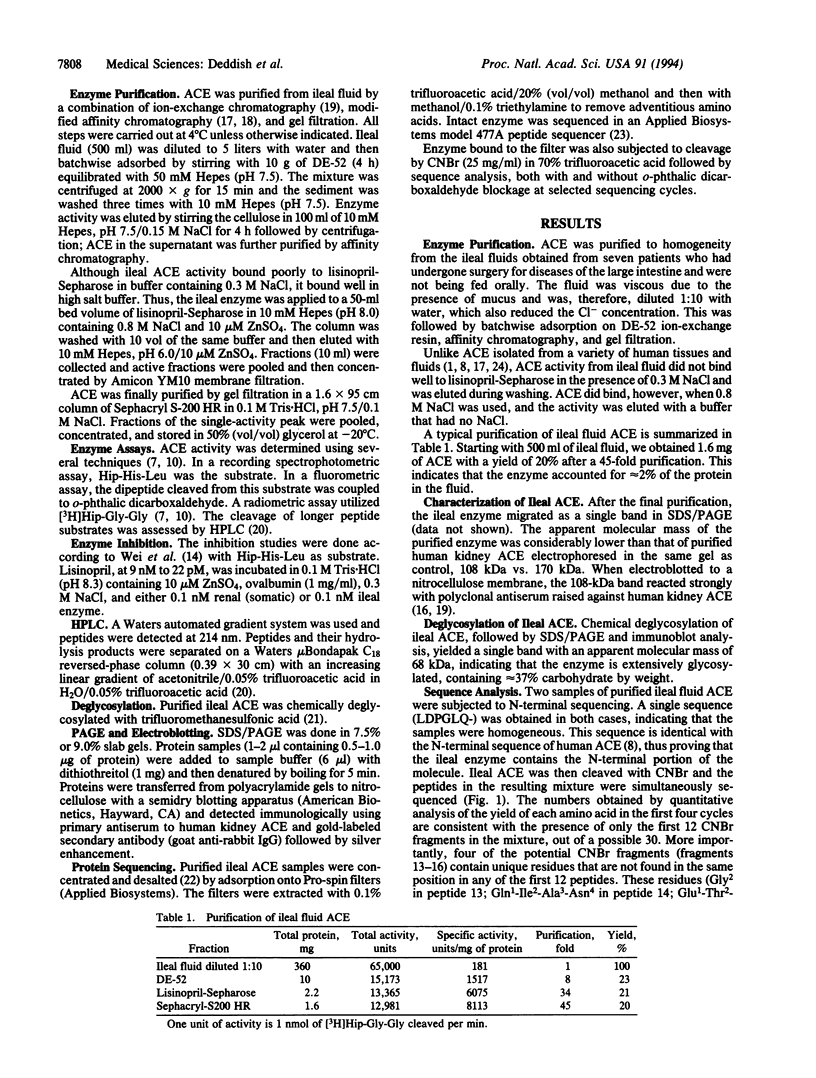
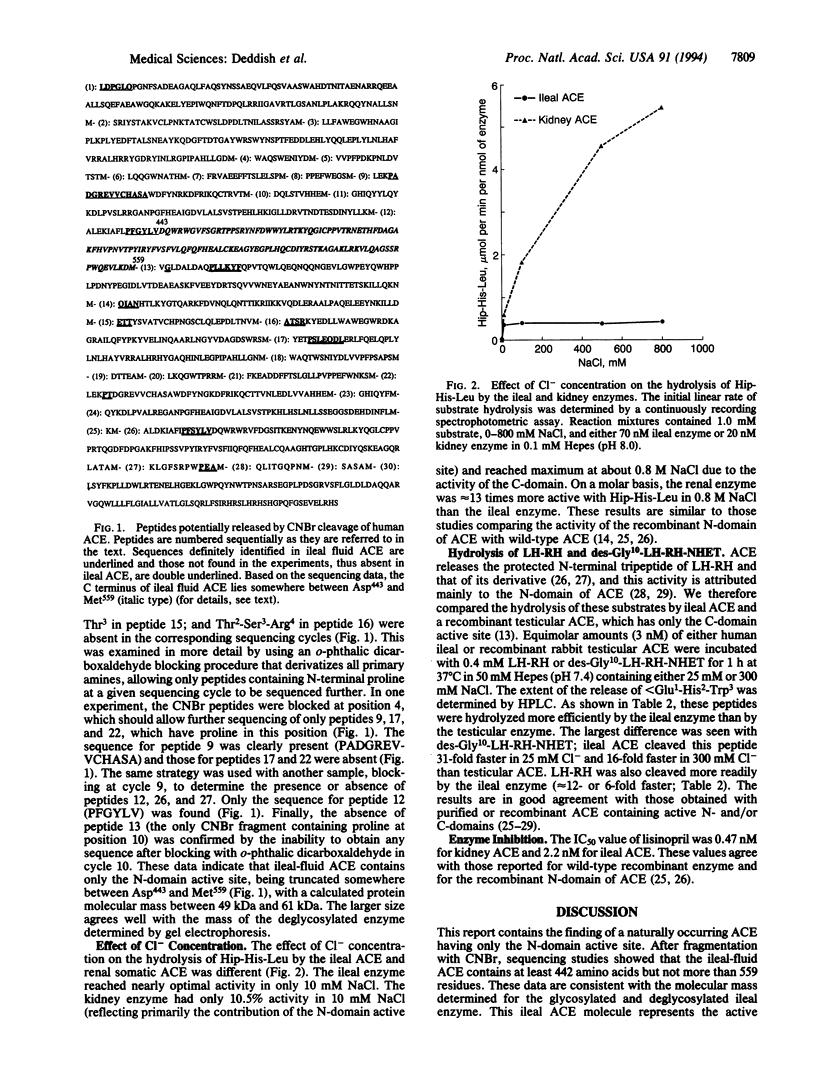
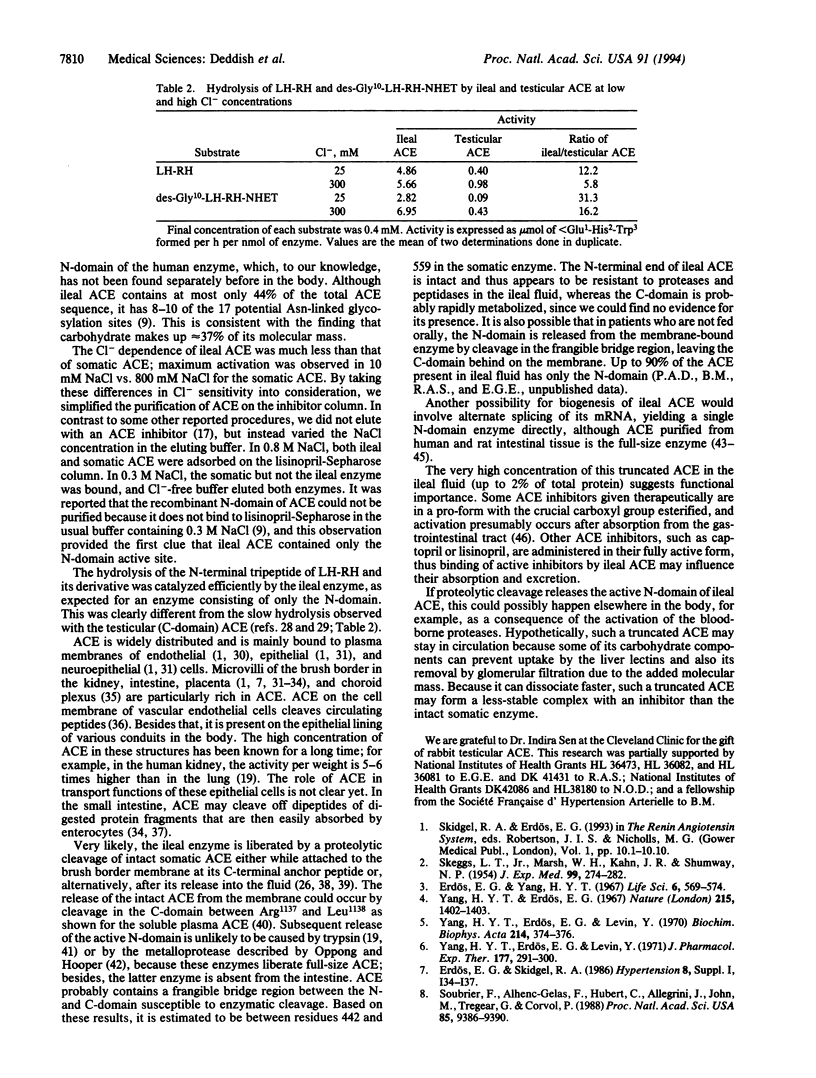
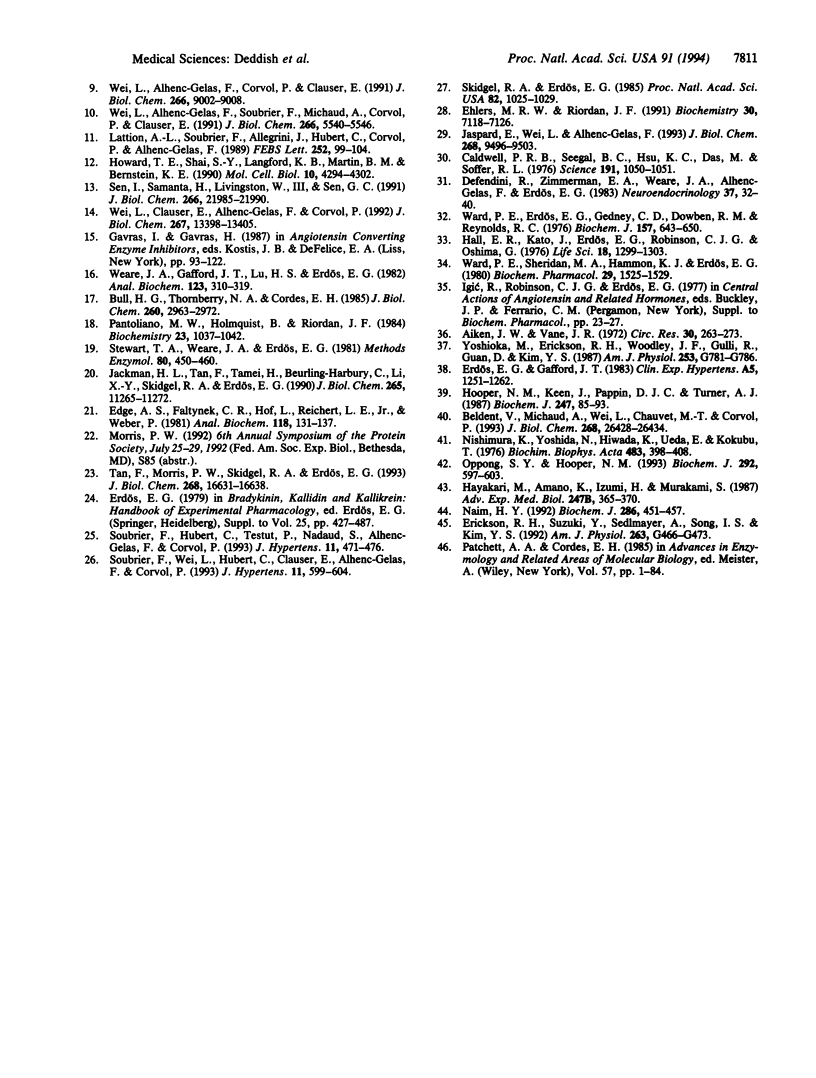
Selected References
These references are in PubMed. This may not be the complete list of references from this article.
- Aiken J. W., Vane J. R. Inhibition of converting enzyme of the renin-angiotensin system in kidneys and hindlegs of dogs. Circ Res. 1972 Mar;30(3):263–273. doi: 10.1161/01.res.30.3.263. [DOI] [PubMed] [Google Scholar]
- Beldent V., Michaud A., Wei L., Chauvet M. T., Corvol P. Proteolytic release of human angiotensin-converting enzyme. Localization of the cleavage site. J Biol Chem. 1993 Dec 15;268(35):26428–26434. [PubMed] [Google Scholar]
- Bull H. G., Thornberry N. A., Cordes E. H. Purification of angiotensin-converting enzyme from rabbit lung and human plasma by affinity chromatography. J Biol Chem. 1985 Mar 10;260(5):2963–2972. [PubMed] [Google Scholar]
- Caldwell P. R., Seegal B. C., Hsu K. C., Das M., Soffer R. L. Angiotensin-converting enzyme: vascular endothelial localization. Science. 1976 Mar 12;191(4231):1050–1051. doi: 10.1126/science.175444. [DOI] [PubMed] [Google Scholar]
- Defendini R., Zimmerman E. A., Weare J. A., Alhenc-Gelas F., Erdös E. G. Angiotensin-converting enzyme in epithelial and neuroepithelial cells. Neuroendocrinology. 1983 Jul;37(1):32–40. doi: 10.1159/000123512. [DOI] [PubMed] [Google Scholar]
- Edge A. S., Faltynek C. R., Hof L., Reichert L. E., Jr, Weber P. Deglycosylation of glycoproteins by trifluoromethanesulfonic acid. Anal Biochem. 1981 Nov 15;118(1):131–137. doi: 10.1016/0003-2697(81)90168-8. [DOI] [PubMed] [Google Scholar]
- Ehlers M. R., Riordan J. F. Angiotensin-converting enzyme: zinc- and inhibitor-binding stoichiometries of the somatic and testis isozymes. Biochemistry. 1991 Jul 23;30(29):7118–7126. doi: 10.1021/bi00243a012. [DOI] [PubMed] [Google Scholar]
- Erdos E. G., Yang H. Y. An enzyme in microsomal fraction of kidney that inactivates bradykinin. Life Sci. 1967 Mar 15;6(6):569–574. doi: 10.1016/0024-3205(67)90090-2. [DOI] [PubMed] [Google Scholar]
- Erdös E. G., Gafford J. T. Human converting enzyme. Clin Exp Hypertens A. 1983;5(7-8):1251–1262. doi: 10.3109/10641968309048855. [DOI] [PubMed] [Google Scholar]
- Erickson R. H., Suzuki Y., Sedlmayer A., Song I. S., Kim Y. S. Rat intestinal angiotensin-converting enzyme: purification, properties, expression, and function. Am J Physiol. 1992 Oct;263(4 Pt 1):G466–G473. doi: 10.1152/ajpgi.1992.263.4.G466. [DOI] [PubMed] [Google Scholar]
- Hall E. R., Kato J., Erdös E. G., Robinson C. J., Oshima G. Angiotensin i-converting enzyme in the nephron. Life Sci. 1976 Jun 1;18(11):1299–1303. doi: 10.1016/0024-3205(76)90208-3. [DOI] [PubMed] [Google Scholar]
- Hayakari M., Amano K., Izumi H., Murakami S. Purification of angiotensin-converting enzyme from human intestine. Adv Exp Med Biol. 1989;247B:365–370. doi: 10.1007/978-1-4615-9546-5_60. [DOI] [PubMed] [Google Scholar]
- Hooper N. M., Keen J., Pappin D. J., Turner A. J. Pig kidney angiotensin converting enzyme. Purification and characterization of amphipathic and hydrophilic forms of the enzyme establishes C-terminal anchorage to the plasma membrane. Biochem J. 1987 Oct 1;247(1):85–93. doi: 10.1042/bj2470085. [DOI] [PMC free article] [PubMed] [Google Scholar]
- Howard T. E., Shai S. Y., Langford K. G., Martin B. M., Bernstein K. E. Transcription of testicular angiotensin-converting enzyme (ACE) is initiated within the 12th intron of the somatic ACE gene. Mol Cell Biol. 1990 Aug;10(8):4294–4302. doi: 10.1128/mcb.10.8.4294. [DOI] [PMC free article] [PubMed] [Google Scholar]
- Jackman H. L., Tan F. L., Tamei H., Beurling-Harbury C., Li X. Y., Skidgel R. A., Erdös E. G. A peptidase in human platelets that deamidates tachykinins. Probable identity with the lysosomal "protective protein". J Biol Chem. 1990 Jul 5;265(19):11265–11272. [PubMed] [Google Scholar]
- Jaspard E., Wei L., Alhenc-Gelas F. Differences in the properties and enzymatic specificities of the two active sites of angiotensin I-converting enzyme (kininase II). Studies with bradykinin and other natural peptides. J Biol Chem. 1993 May 5;268(13):9496–9503. [PubMed] [Google Scholar]
- Lattion A. L., Soubrier F., Allegrini J., Hubert C., Corvol P., Alhenc-Gelas F. The testicular transcript of the angiotensin I-converting enzyme encodes for the ancestral, non-duplicated form of the enzyme. FEBS Lett. 1989 Jul 31;252(1-2):99–104. doi: 10.1016/0014-5793(89)80897-x. [DOI] [PubMed] [Google Scholar]
- Naim H. Y. Angiotensin-converting enzyme of the human small intestine. Subunit and quaternary structure, biosynthesis and membrane association. Biochem J. 1992 Sep 1;286(Pt 2):451–457. doi: 10.1042/bj2860451. [DOI] [PMC free article] [PubMed] [Google Scholar]
- Nishimura K., Yoshida N., Hiwada K., Ueda E., Kokubu T. Purification of angiotensin I-converting enzyme from human lung. Biochim Biophys Acta. 1977 Aug 11;483(2):398–408. doi: 10.1016/0005-2744(77)90067-5. [DOI] [PubMed] [Google Scholar]
- Oppong S. Y., Hooper N. M. Characterization of a secretase activity which releases angiotensin-converting enzyme from the membrane. Biochem J. 1993 Jun 1;292(Pt 2):597–603. doi: 10.1042/bj2920597. [DOI] [PMC free article] [PubMed] [Google Scholar]
- Pantoliano M. W., Holmquist B., Riordan J. F. Affinity chromatographic purification of angiotensin converting enzyme. Biochemistry. 1984 Feb 28;23(5):1037–1042. doi: 10.1021/bi00300a036. [DOI] [PubMed] [Google Scholar]
- SKEGGS L. T., Jr, MARSH W. H., KAHN J. R., SHUMWAY N. P. The existence of two forms of hypertensin. J Exp Med. 1954 Mar;99(3):275–282. doi: 10.1084/jem.99.3.275. [DOI] [PMC free article] [PubMed] [Google Scholar]
- Sen I., Samanta H., Livingston W., 3rd, Sen G. C. Establishment of transfected cell lines producing testicular angiotensin-converting enzyme. Structural relationship between its secreted and cellular forms. J Biol Chem. 1991 Nov 15;266(32):21985–21990. [PubMed] [Google Scholar]
- Skidgel R. A., Erdös E. G. Novel activity of human angiotensin I converting enzyme: release of the NH2- and COOH-terminal tripeptides from the luteinizing hormone-releasing hormone. Proc Natl Acad Sci U S A. 1985 Feb;82(4):1025–1029. doi: 10.1073/pnas.82.4.1025. [DOI] [PMC free article] [PubMed] [Google Scholar]
- Soubrier F., Alhenc-Gelas F., Hubert C., Allegrini J., John M., Tregear G., Corvol P. Two putative active centers in human angiotensin I-converting enzyme revealed by molecular cloning. Proc Natl Acad Sci U S A. 1988 Dec;85(24):9386–9390. doi: 10.1073/pnas.85.24.9386. [DOI] [PMC free article] [PubMed] [Google Scholar]
- Soubrier F., Hubert C., Testut P., Nadaud S., Alhenc-Gelas F., Corvol P. Molecular biology of the angiotensin I converting enzyme: I. Biochemistry and structure of the gene. J Hypertens. 1993 May;11(5):471–476. doi: 10.1097/00004872-199305000-00001. [DOI] [PubMed] [Google Scholar]
- Soubrier F., Wei L., Hubert C., Clauser E., Alhenc-Gelas F., Corvol P. Molecular biology of the angiotensin I converting enzyme: II. Structure-function. Gene polymorphism and clinical implications. J Hypertens. 1993 Jun;11(6):599–604. doi: 10.1097/00004872-199306000-00003. [DOI] [PubMed] [Google Scholar]
- Stewart T. A., Weare J. A., Erdös E. G. Human peptidyl dipeptidase (converting enzyme, kininase II). Methods Enzymol. 1981;80(Pt 100):450–460. doi: 10.1016/s0076-6879(81)80039-0. [DOI] [PubMed] [Google Scholar]
- Tan F., Morris P. W., Skidgel R. A., Erdös E. G. Sequencing and cloning of human prolylcarboxypeptidase (angiotensinase C). Similarity to both serine carboxypeptidase and prolylendopeptidase families. J Biol Chem. 1993 Aug 5;268(22):16631–16638. [PubMed] [Google Scholar]
- Ward P. E., Erdös E. G., Gedney C. D., Dowben R. M., Reynolds R. C. Isolation of membrane-bound renal enzymes that metabolize kinins and angiotensins. Biochem J. 1976 Sep 1;157(3):643–650. doi: 10.1042/bj1570643. [DOI] [PMC free article] [PubMed] [Google Scholar]
- Ward P. E., Sheridan M. A., Hammon K. J., Erdös E. G. Angiotensin I converting enzyme (kininase II) of the brush border of human and swine intestine. Biochem Pharmacol. 1980 Jun 1;29(11):1525–1529. doi: 10.1016/0006-2952(80)90603-6. [DOI] [PubMed] [Google Scholar]
- Weare J. A., Gafford J. T., Lu H. S., Erdös E. G. Purification of human kidney angiotensin I converting enzyme using reverse-immunoadsorption chromatography. Anal Biochem. 1982 Jul 1;123(2):310–319. doi: 10.1016/0003-2697(82)90451-1. [DOI] [PubMed] [Google Scholar]
- Wei L., Alhenc-Gelas F., Corvol P., Clauser E. The two homologous domains of human angiotensin I-converting enzyme are both catalytically active. J Biol Chem. 1991 May 15;266(14):9002–9008. [PubMed] [Google Scholar]
- Wei L., Alhenc-Gelas F., Soubrier F., Michaud A., Corvol P., Clauser E. Expression and characterization of recombinant human angiotensin I-converting enzyme. Evidence for a C-terminal transmembrane anchor and for a proteolytic processing of the secreted recombinant and plasma enzymes. J Biol Chem. 1991 Mar 25;266(9):5540–5546. [PubMed] [Google Scholar]
- Wei L., Clauser E., Alhenc-Gelas F., Corvol P. The two homologous domains of human angiotensin I-converting enzyme interact differently with competitive inhibitors. J Biol Chem. 1992 Jul 5;267(19):13398–13405. [PubMed] [Google Scholar]
- Yang H. Y., Erdös E. G., Levin Y. A dipeptidyl carboxypeptidase that converts angiotensin I and inactivates bradykinin. Biochim Biophys Acta. 1970 Aug 21;214(2):374–376. doi: 10.1016/0005-2795(70)90017-6. [DOI] [PubMed] [Google Scholar]
- Yang H. Y., Erdös E. G., Levin Y. Characterization of a dipeptide hydrolase (kininase II: angiotensin I converting enzyme). J Pharmacol Exp Ther. 1971 Apr;177(1):291–300. [PubMed] [Google Scholar]
- Yang H. Y., Erdös E. G. Second kininase in human blood plasma. Nature. 1967 Sep 23;215(5108):1402–1403. doi: 10.1038/2151402a0. [DOI] [PubMed] [Google Scholar]
- Yoshioka M., Erickson R. H., Woodley J. F., Gulli R., Guan D., Kim Y. S. Role of rat intestinal brush-border membrane angiotensin-converting enzyme in dietary protein digestion. Am J Physiol. 1987 Dec;253(6 Pt 1):G781–G786. doi: 10.1152/ajpgi.1987.253.6.G781. [DOI] [PubMed] [Google Scholar]


